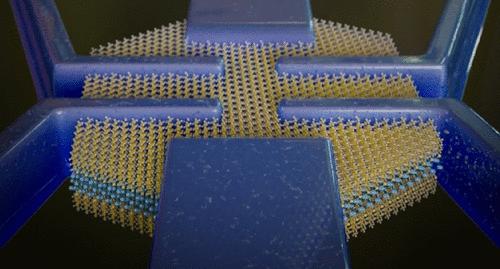当前位置:
X-MOL 学术
›
J. Am. Chem. Soc.
›
论文详情
Our official English website, www.x-mol.net, welcomes your
feedback! (Note: you will need to create a separate account there.)
Hexagonal Hybrid Bismuthene by Molecular Interface Engineering
Journal of the American Chemical Society ( IF 14.4 ) Pub Date : 2023-06-01 , DOI: 10.1021/jacs.2c13036 Christian Dolle 1, 2 , Víctor Oestreicher 1 , Alberto M Ruiz 1 , Malte Kohring 3 , Francisco Garnes-Portolés 4 , Mingjian Wu 5 , Gabriel Sánchez-Santolino 6 , Alvaro Seijas-Da Silva 1 , Marta Alcaraz 1 , Yolita M Eggeler 2 , Erdmann Spiecker 5 , Josep Canet-Ferrer 1 , Antonio Leyva-Pérez 4 , Heiko B Weber 3 , María Varela 6 , José J Baldoví 1 , Gonzalo Abellán 1
Journal of the American Chemical Society ( IF 14.4 ) Pub Date : 2023-06-01 , DOI: 10.1021/jacs.2c13036 Christian Dolle 1, 2 , Víctor Oestreicher 1 , Alberto M Ruiz 1 , Malte Kohring 3 , Francisco Garnes-Portolés 4 , Mingjian Wu 5 , Gabriel Sánchez-Santolino 6 , Alvaro Seijas-Da Silva 1 , Marta Alcaraz 1 , Yolita M Eggeler 2 , Erdmann Spiecker 5 , Josep Canet-Ferrer 1 , Antonio Leyva-Pérez 4 , Heiko B Weber 3 , María Varela 6 , José J Baldoví 1 , Gonzalo Abellán 1
Affiliation

|
High-quality devices based on layered heterostructures are typically built from materials obtained by complex solid-state physical approaches or laborious mechanical exfoliation and transfer. Meanwhile, wet-chemically synthesized materials commonly suffer from surface residuals and intrinsic defects. Here, we synthesize using an unprecedented colloidal photocatalyzed, one-pot redox reaction a few-layers bismuth hybrid of “electronic grade” structural quality. Intriguingly, the material presents a sulfur-alkyl-functionalized reconstructed surface that prevents it from oxidation and leads to a tuned electronic structure that results from the altered arrangement of the surface. The metallic behavior of the hybrid is supported by ab initio predictions and room temperature transport measurements of individual nanoflakes. Our findings indicate how surface reconstructions in two-dimensional (2D) systems can promote unexpected properties that can pave the way to new functionalities and devices. Moreover, this scalable synthetic process opens new avenues for applications in plasmonics or electronic (and spintronic) device fabrication. Beyond electronics, this 2D hybrid material may be of interest in organic catalysis, biomedicine, or energy storage and conversion.
中文翻译:

分子界面工程六方杂化铋
基于分层异质结构的高质量设备通常由通过复杂的固态物理方法或费力的机械剥离和转移获得的材料制成。同时,湿化学合成材料通常存在表面残留物和固有缺陷。在这里,我们使用前所未有的胶体光催化单锅氧化还原反应合成了具有“电子级”结构质量的几层铋杂化物。有趣的是,该材料呈现出硫烷基功能化的重建表面,可防止其氧化并导致由表面排列改变产生的调谐电子结构。混合动力车的金属行为由ab initio支持单个纳米薄片的预测和室温传输测量。我们的发现表明二维 (2D) 系统中的表面重建如何促进意想不到的特性,从而为新功能和设备铺平道路。此外,这种可扩展的合成过程为等离子或电子(和自旋电子)设备制造的应用开辟了新途径。除了电子学之外,这种二维混合材料还可能用于有机催化、生物医学或能量储存和转换。
更新日期:2023-06-01
中文翻译:

分子界面工程六方杂化铋
基于分层异质结构的高质量设备通常由通过复杂的固态物理方法或费力的机械剥离和转移获得的材料制成。同时,湿化学合成材料通常存在表面残留物和固有缺陷。在这里,我们使用前所未有的胶体光催化单锅氧化还原反应合成了具有“电子级”结构质量的几层铋杂化物。有趣的是,该材料呈现出硫烷基功能化的重建表面,可防止其氧化并导致由表面排列改变产生的调谐电子结构。混合动力车的金属行为由ab initio支持单个纳米薄片的预测和室温传输测量。我们的发现表明二维 (2D) 系统中的表面重建如何促进意想不到的特性,从而为新功能和设备铺平道路。此外,这种可扩展的合成过程为等离子或电子(和自旋电子)设备制造的应用开辟了新途径。除了电子学之外,这种二维混合材料还可能用于有机催化、生物医学或能量储存和转换。











































 京公网安备 11010802027423号
京公网安备 11010802027423号